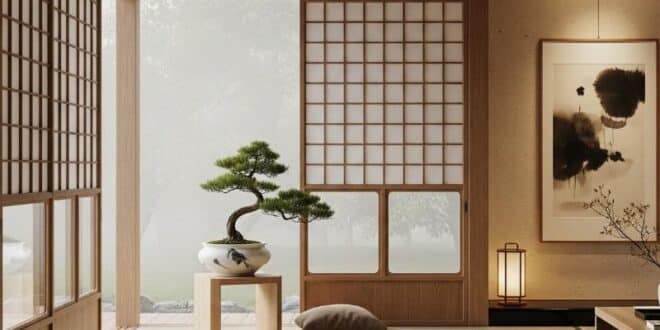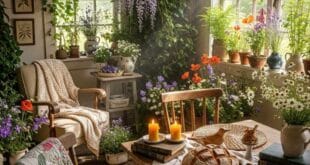Japandi Style
In the world of interior design, few fusions are as serene and soulful as Japandi. This hybrid style masterfully blends the rustic minimalism of Japanese aesthetics with the functional simplicity of Scandinavian decor. It’s where the Japanese philosophy of wabi-sabi—finding beauty in imperfection and nature—meets the Scandinavian concept of hygge—a sense of cozy, contented well-being. The result is a tranquil, uncluttered, and deeply harmonious sanctuary.
Within this balanced world, plants play a crucial role. They are not chosen in abundance, but with quiet intention. A Japandi plant is a living sculpture, selected for its interesting form, clean lines, and its ability to evoke a sense of calm. The focus is on quality over quantity, celebrating natural textures and imperfect, organic shapes.
To help you cultivate this peaceful atmosphere, here are 10 Zen-like Japandi style plants that perfectly embody the tranquil and functional spirit of Japandi design.
Ficus Ginseng (Bonsai) – The Wabi-Sabi Master
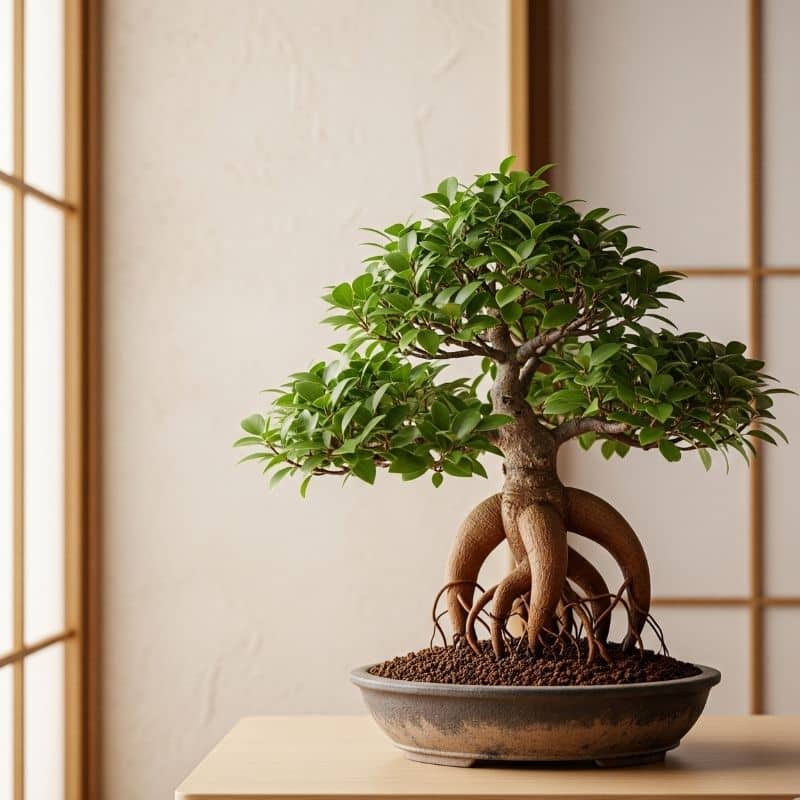
The Ficus Ginseng, characterized by its thick, twisted roots and a delicate canopy of shiny leaves, perfectly embodies the Japanese concept of wabi-sabi. This miniature, ancient-looking tree symbolizes the passage of time, strength, and the beauty found in imperfection. The Japandi Connection: The philosophy of Japandi celebrates natural, imperfect forms over mass-produced perfection. Because the Ficus Ginseng’s tangled, aerial roots are unique and asymmetrical, it serves as a living sculpture that embodies this principle. Therefore, it is not just a plant but a contemplative piece of art that encourages mindfulness and an appreciation for the beauty of aging.
- Aesthetic Contribution: Adds a strong, sculptural, and organic focal point.
- Styling & Materials: It thrives in a shallow, rustic, and often imperfect ceramic bowl (a classic bonsai pot) in a dark, earthy tone. Place it on a low-profile wooden table.
- The “Zen” Factor: The act of pruning and caring for a bonsai is a meditative practice, promoting patience and a deep connection with the plant.
Snake Plant (Sansevierina trifasciata) – The Scandi Structure
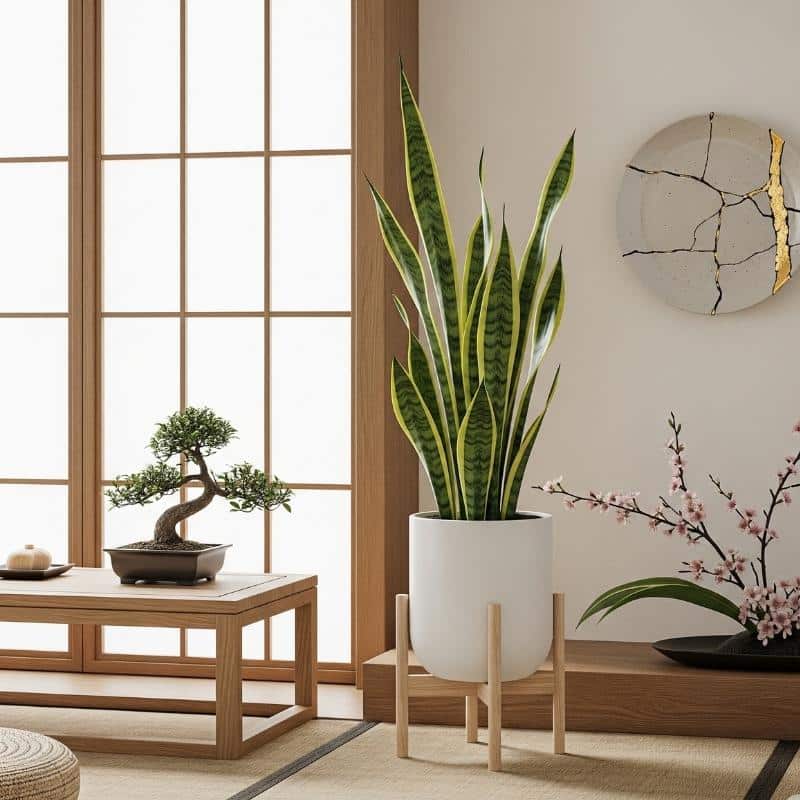
The always dependable Snake Plant perfectly highlights the Scandinavian aspect of the design equation. Its clean, sharp, vertical lines provide a grounding architectural element that mirrors the functional simplicity of Scandinavian furniture and design.
The Japandi Connection: Japandi style is built on a foundation of clean lines and uncluttered space. Because the Snake Plant grows vertically and contained, it provides a powerful structural element without creating any visual clutter. As a result, it perfectly balances the more organic, flowing forms of other Japandi elements, creating a harmonious and well-ordered space.
- Aesthetic Contribution: A strong, graphic, and architectural vertical line.
- Styling & Materials: Looks stunning in a simple, matte-finished ceramic pot in a neutral color (white, grey, or black) or placed within a light-wood plant stand.
- The “Zen” Factor: Its incredible self-sufficiency is a lesson in stillness. It requires minimal intervention, adding a quiet, constant, and calming presence to a room.
Ponytail Palm (Beaucarnea recurvata) – The Patient Sculpture
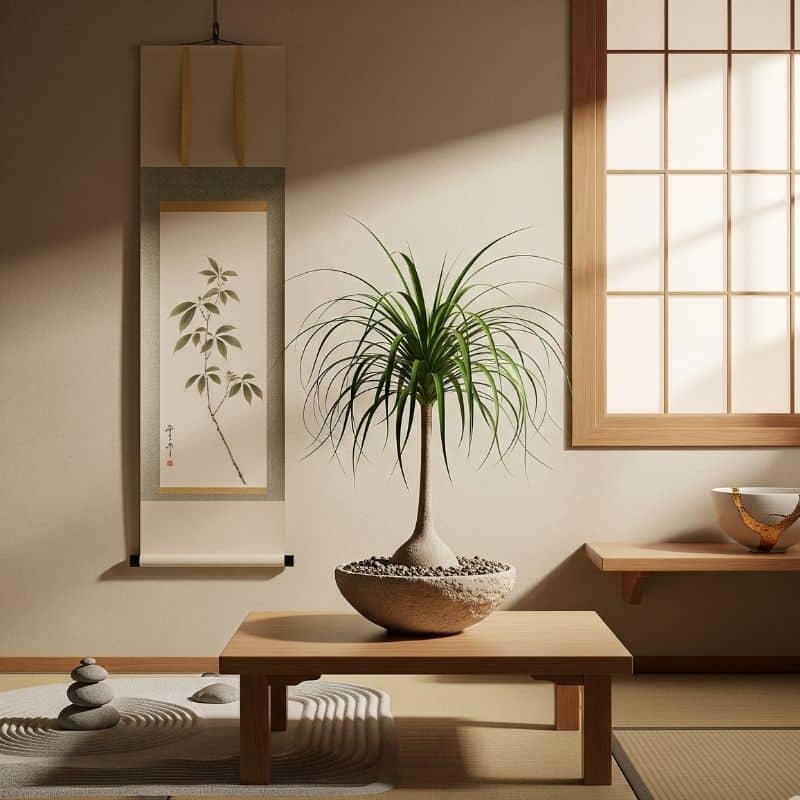
The Ponytail Palm is a plant of beautiful contrasts. Its swollen, bulbous base has a sturdy, rock-like quality, while its long, cascading leaves are fine and flowing like water. This duality makes it a fascinating and deeply calming presence.
The Japandi Connection: This plant exemplifies the essence of balance, a fundamental principle of Japanese design. With its sturdy, grounded base paired with a light, delicate canopy, it symbolizes the harmony between resilience and softness. Therefore, its sculptural form becomes a focal point for meditation and a reminder of the balanced forces in nature.
- Aesthetic Contribution: A unique, sculptural form that offers both texture and a graceful silhouette.
- Styling & Materials: A shallow, wide bowl-like planter made of stone or rough, sand-colored ceramic will showcase its unique trunk.
- The “Zen” Factor: Its incredibly slow growth teaches patience. It is a plant that marks the slow, steady passage of time, encouraging a more mindful and unhurried pace of life.
Olive Tree (Olea europaea) – The Muted Palette
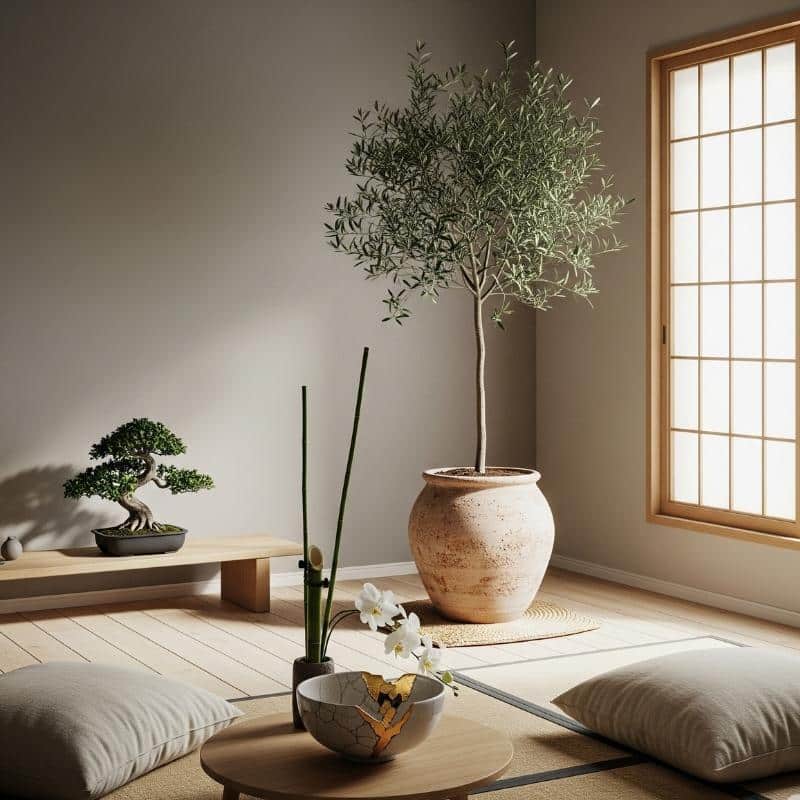
An indoor Olive Tree, with its silvery-green leaves and gnarled, ancient-looking trunk, perfectly captures the Japandi color palette and its appreciation for rustic, natural materials. It is sophisticated, subtle, and serene.
The Japandi Connection: Japandi design avoids bright, jarring colors in favor of a muted, earthy, and natural palette. Because the Olive Tree’s foliage has a soft, grey-green hue, it blends seamlessly with the light woods, beige linens, and soft greys of a Japandi interior. This results in a calm, cohesive, and sophisticated atmosphere that feels deeply connected to the earth.
- Aesthetic Contribution: A light, airy structure and a beautiful, muted color palette.
- Styling & Materials: It pairs beautifully with rustic, unglazed terracotta pots or simple, off-white ceramic planters.
- The “Zen” Factor: The sight of its delicate leaves can evoke a sense of peace and a connection to ancient, sun-drenched landscapes, offering a moment of mental escape.
Indoor Bamboo – The Line of Tranquility
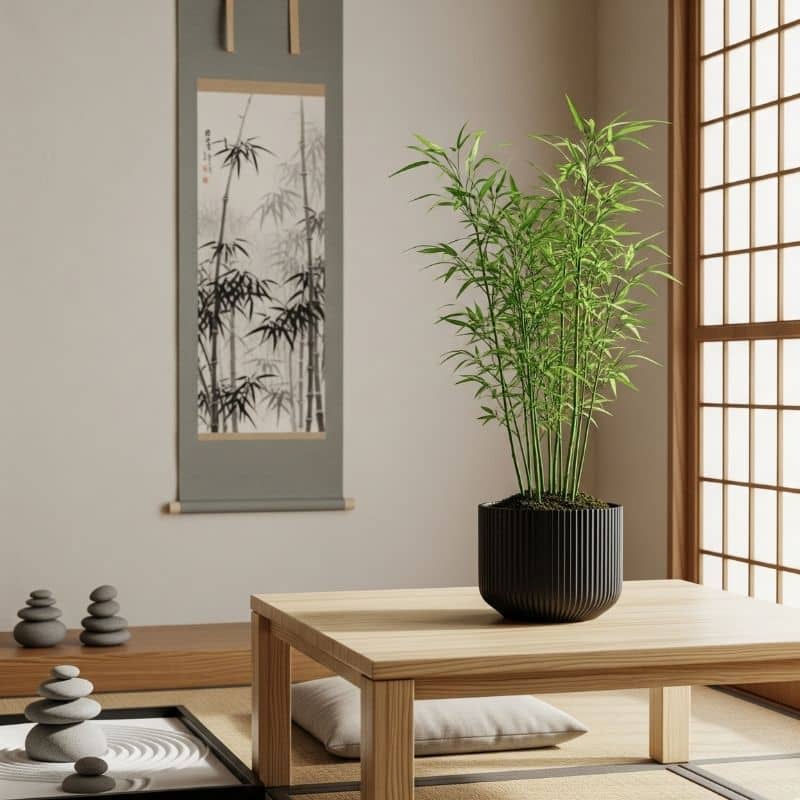
Bamboo is a cornerstone of Japanese aesthetics, symbolizing strength, flexibility, and simplicity. A simple arrangement of Lucky Bamboo in water or a potted variety can instantly bring a Zen-like quality to a space.
The Japandi Connection: Both Japanese and Scandinavian design celebrate the beauty of raw materials and simple, linear forms. Because bamboo consists of clean, vertical lines and a vibrant green color, it acts as a living divider or a simple, graphic accent. Therefore, it adds a touch of organic minimalism that is central to the Japandi spirit.
- Aesthetic Contribution: Creates strong, clean, vertical lines and a vibrant pop of natural green.
- Styling & Materials: Lucky Bamboo looks stunning in a simple glass vessel with river stones. Potted bamboo pairs well with dark, minimalist ceramic planters.
- The “Zen” Factor: The sound of its leaves rustling gently is known to be incredibly calming. Its association with Zen gardens makes it a natural choice for a space designed for meditation.
Orchid (Phalaenopsis) – The Ikebana Spirit
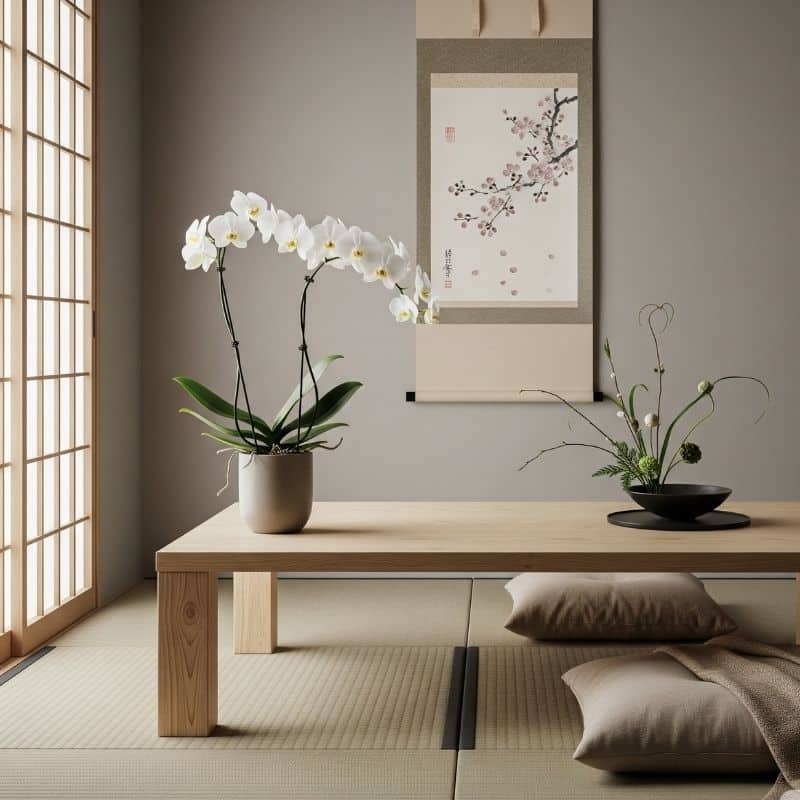
A single, elegant Orchid embodies the Japanese art of flower arrangement, Ikebana, which emphasizes shape, line, and form. Its graceful arch and perfectly formed blooms are a statement of intentional, uncluttered beauty.
The Japandi Connection: Both cultures value craftsmanship and doing simple things well. Because an Orchid presents a single, perfect form, it represents the philosophy of choosing one beautiful object over a dozen lesser ones. This results in a focused point of beauty that encourages quiet appreciation and does not contribute to clutter.
- Aesthetic Contribution: An elegant, sculptural arch of flowers that provides a touch of refined color.
- Styling & Materials: A simple, unadorned pot in a neutral color is all that’s needed. The plant itself is the art.
- The “Zen” Factor: The patient process of watering and caring for an Orchid, and the reward of seeing it re-bloom, is a deeply satisfying and mindful ritual.
Asparagus Fern (Asparagus setaceus) – The Softening Cloud
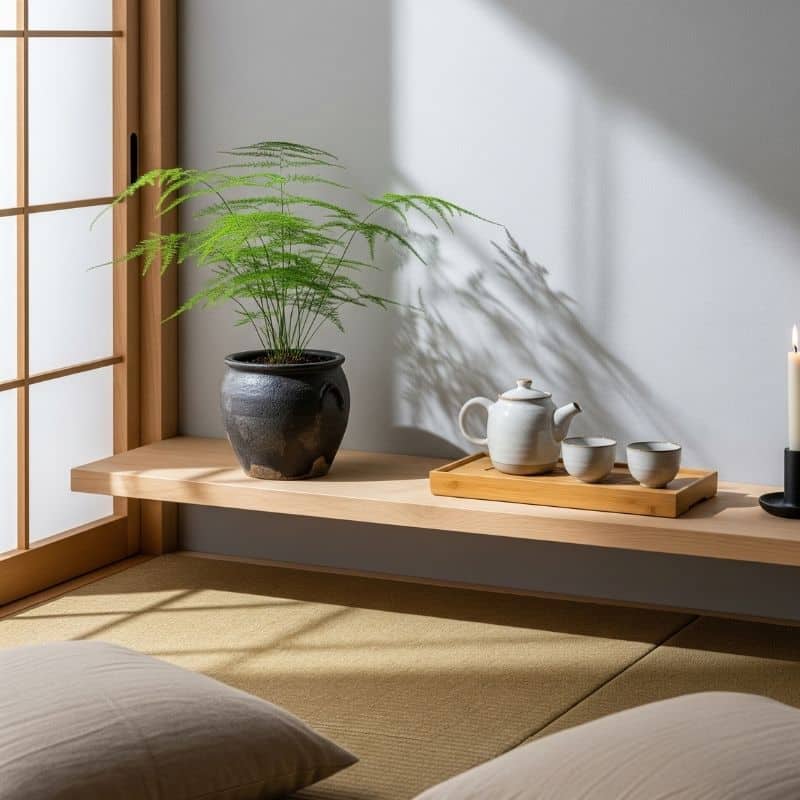
The Asparagus Fern’s incredibly fine, cloud-like foliage is the perfect element to soften the clean, sometimes hard, lines of minimalist Japandi furniture.
The Japandi Connection: Japandi is not cold; it is warm and inviting. Because the Asparagus Fern has such a delicate and soft texture, it introduces a necessary layer of visual comfort. As a result, it balances the starkness of minimalism with the cozy, natural feeling of hygge.
- Aesthetic Contribution: A unique, fine, and airy texture that adds depth and softness.
- Styling & Materials: Looks wonderful in a dark, rustic stoneware pot, creating a contrast between the soft foliage and the heavy base.
- The “Zen” Factor: Its ethereal appearance is calming to the eye, offering a soft place for the gaze to rest in an otherwise structured room.
Horsetail Reed (Equisetum hyemale) – The Living Screen
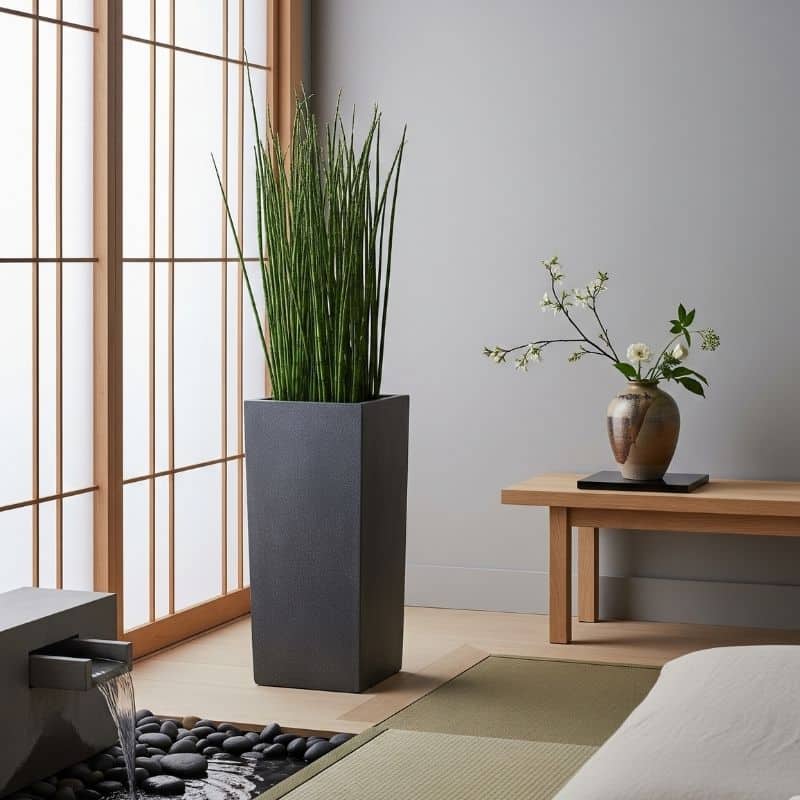
This plant is the definition of a living, architectural line. Its straight, segmented, reed-like stems look like a miniature bamboo forest and create a powerful graphic statement.
The Japandi Connection: The use of screens and vertical lines to divide space is common in Japanese architecture. Because the Horsetail Reed grows in a dense, upright cluster, it can act as a natural, living screen or a purely graphic element. Therefore, it perfectly blends the love of natural forms with a minimalist, geometric sensibility.
- Aesthetic Contribution: A strong, vertical, and repetitive pattern that is both modern and deeply organic.
- Styling & Materials: Thrives in a modern, rectangular planter, which emphasizes its linear quality. It loves to be kept moist.
- The “Zen” Factor: Its simple, repeating form is deeply meditative and brings the tranquility of a Japanese water garden indoors.
Japanese Maple (Acer palmatum) – The Touch of a Season
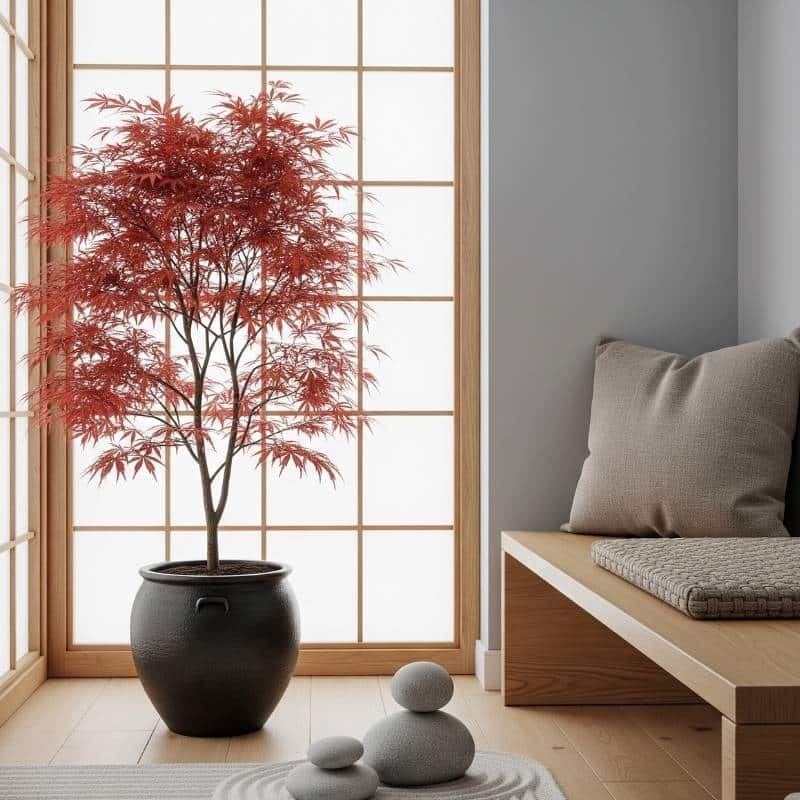
For a balcony or a very bright, cool indoor spot, a dwarf Japanese Maple is an unparalleled choice. Its delicate, hand-shaped leaves and sculptural branches change color with the seasons, bringing the rhythm of nature indoors.
The Japandi Connection: Both cultures have a deep appreciation for the changing seasons. Because the Japanese Maple so dramatically marks the passage of time with its changing foliage, it serves as a living calendar. This fosters a deeper connection to the natural world and its cycles, a core value in both Japanese and Scandinavian life.
- Aesthetic Contribution: Provides stunning, delicate foliage and seasonal color, from vibrant green to deep crimson.
- Styling & Materials: A classic, dark, unglazed ceramic pot allows the beauty of the leaves and branches to be the focus.
- The “Zen” Factor: Observing its leaves unfurl in spring or turn color in autumn is a profound and mindful experience.
Moss (Kokedama or Terrarium) – The Essence of Wabi-Sabi
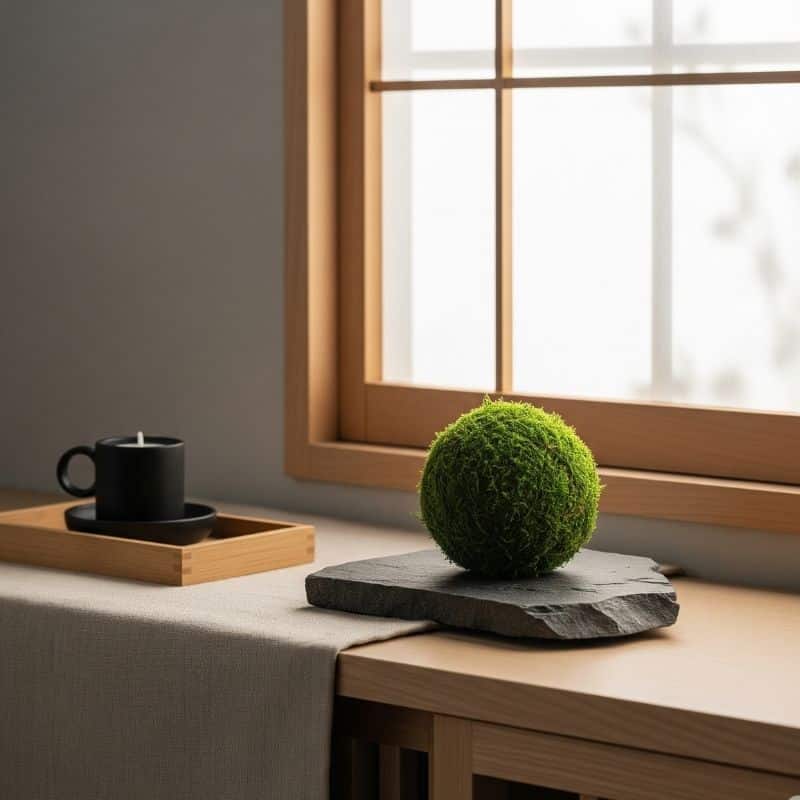
Moss represents the beauty of the small, the overlooked, and the imperfect. Whether displayed as a Kokedama (a Japanese moss ball) or in a simple glass terrarium, it is a patch of condensed, ancient nature.
The Japandi Connection: Moss is the ultimate expression of wabi-sabi. Because it is humble, textured, and thrives in shadow, it represents a quiet, resilient beauty that doesn’t shout for attention. As a result, it brings a sense of history, tranquility, and the damp, earthy scent of a forest floor into the clean, simple Japandi home.
- Aesthetic Contribution: A vibrant, deep green color and a unique, velvety texture.
- Styling & Materials: Kokedama looks beautiful resting on a piece of slate or a simple ceramic dish. A moss terrarium in a clean glass vessel is a self-contained world.
- The “Zen” Factor: Creating and maintaining a moss garden or Kokedama is a deeply tactile and meditative craft, connecting you directly with the earth.
Finding Your Balance
The art of Japandi is not in following strict rules, but in finding a personal sense of balance. It’s about creating a space that is both calm and warm, simple and soulful. Choose one or two of these plants with intention, give them a beautiful, simple home, and allow them to bring their quiet, Zen-like energy into your sanctuary.

